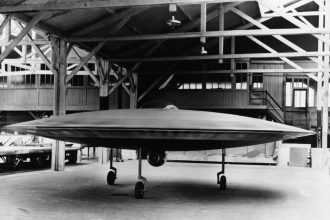On a clear day over the East China Sea, the voice of a Chinese military official crackles over the radio of a Canadian military patrol plane to tell it to stay away from Pengjia, an islet controlled by Taiwan but claimed by Beijing.
“We were nowhere near [the islet],” the flight’s US crew commander told the Financial Times. “Close is 12 miles — we were 35 to 40 miles away.”
The job of the Aurora CP-140 long-range surveillance aircraft is to “detect, deter and disrupt” tankers carrying illicit shipments of oil and petroleum products to North Korea, often from Taiwan and China, in violation of UN sanctions.
But the mission, which feeds its findings to a US-led grouping that includes members of the Five Eyes intelligence alliance, has angered Beijing, which suspects western countries of using the pretext of North Korean sanctions violations to bulk up their military presence in the region.
“It is not innocent passage but clearly provocative behaviour,” said Cao Yanzhong, a research fellow at the People’s Liberation Army’s Academy of Military Sciences. “China’s armed forces initiating surveillance against them is a natural reaction and an inevitable choice as we seek to safeguard our national security and sovereignty.”
Under UN sanctions, transfers of refined oil and petroleum products to North Korea are capped at 500,000 barrels a year. This forces leader Kim Jong Un’s regime to rely on a criminal network of brokers and smugglers to sustain its economy.
The Aurora’s flights are designed to assist enforcement of the sanctions regime, which the US has accused China of undermining. But the mission has also become enmeshed in growing geopolitical tensions between China and the west in the strategically important Pacific region.
With the FT on board one recent flight, the 35-metre Aurora takes off from the US Kadena Air Base on Okinawa, leaving the tropical beaches of the southern Japanese island behind and heading south-west across the East China Sea towards the Taiwan Strait, steering clear of Chinese and Taiwanese airspace.
“We try not to poke the bear,” said one of the Canadian pilots over the roar of the plane’s turboprop engines. Members of the Aurora’s crew declined to be named for security reasons. “We keep doing our jobs, but we do them in a way that won’t make [the Chinese] too unhappy.”
China’s opposition to the flights has grown increasingly assertive. The previous day, a Chinese fighter jet flew within 5 metres of the unarmed Canadian aircraft, releasing flares immediately in front of its nose.
“We were flying in international airspace,” said Major General Iain Huddleston, commander of Canada’s 1st Air Division, who was on board during the incident. “The proximity and the aggressive manoeuvring of the Chinese aircraft, and the firing of the flares in front to the point where they nearly hit us, was unnecessary and unsafe.”

While the FT was on board, a Chinese fighter pulled alongside the Aurora, backing off and climbing into the distance once the Canadian plane started to turn away from the mainland. It was also briefly intercepted by a Taiwanese jet after entering Taiwan’s air defence identification zone.
Both intercepts were “totally safe and professional”, the Aurora’s pilots said. But they confirmed the Canadian plane had been subjected to aggressive PLA Air Force manoeuvres in the past.
Last month, the Pentagon accused Chinese fighter jets of conducting several hundred “risky and coercive” aerial intercepts against US and allied aircraft over the past two years.
“They have every right to intercept us [while operating near their airspace], but they don’t have the right to do it unsafely,” said Huddleston.
“We are in the area helping to enforce the UN resolution,” he added. “[China is] a signatory to that particular resolution, so I don’t know why they would attempt to undermine our mission.”
He admitted the Aurora had “momentarily” strayed into Chinese airspace “almost two years ago”, but stressed it was an isolated incident.
Beijing has dismissed criticism of its air force’s tactics, saying western militaries should keep their distance from China’s borders. The flights “create a sense of unacceptability or even a bit of humiliation for Chinese military elites because they regard these US military activities as a show of force,” said Li Mingjiang a professor at Nanyang Technological University in Singapore.

The Aurora sends its findings to the Enforcement Coordination Cell, which in addition to the Five Eyes allies includes Japan, South Korea, France, Germany and Italy.
US Navy Captain Jennifer Kidd, who oversees the ECC, told the FT in an interview at the US Yokosuka naval base outside Tokyo that “North Korea has blown through” the UN’s energy import limit “every year, and it keeps getting earlier every year”.
Kidd said Beijing allows ships involved in North Korea’s illicit oil trade to operate with “impunity” along the border of China’s maritime contiguous zone, an area up to 24 nautical miles off the coast, and to stop for repairs in Chinese ports. “The US provided over a hundred images of vessels . . . and said ‘Look, here is your evidence, please take action.’ But we have not seen them do so.”
China’s foreign ministry said the UN resolutions did not authorise the deployment of military forces or surveillance “under the pretext of monitoring violations”, and called on the US and its allies to “immediately cease any adventurous and provocative actions near China’s coast”.
Kidd acknowledged that for the US, the ECC’s role in co-ordinating allied intelligence gathering in east Asia offers “intangible” benefits beyond the North Korea issue.
“If something bad were to happen . . . I don’t want to use Taiwan as the example, but if we needed to do combined operations wherever it is, whether that is for disaster relief or an actual conflict scenario, the ability to work, communicate and operate together is the core of what we do.”
But she added that “if China were to actually enforce these sanctions, we’d have much less of a problem.”
“If China is not going to use its massive navy to interdict these vessels, if it’s not going to stop them from going into and using its ports, my personal view is that they don’t have a right to question our operations.”
On board the Aurora, its crew spots a Gabon-flagged vessel suspected of helping deliver oil to North Korea. The Canadian plane descends to an altitude of 500ft to investigate.
“Because we are down at a low level, because we can get live imagery, and because we can talk to them on the radios, we can get high-fidelity information that is not available when tracking by satellite,” said the Aurora’s tactical co-ordinator.
The plane also acts as a deterrent, he added. “We stop people feeling comfortable when making these transfers, because they know we might suddenly sweep out of the clouds.”
Additional reporting by Kathrin Hille in Taipei and Joe Leahy in Beijing
Read the full article here




